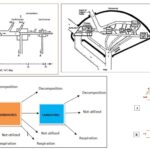1. If you did “overload” your Ni+2 Agarose column with a GCE sample that contained too much rGFP, would you expect to see a band in the W2 lane of the Western Blot? If so what is it’s MW? Would you expect to see a band in the E2 lane? If so what is it’s MW? 2. Chromatography columns have a limited protein binding capacity. During the Ni2+ agarose column lab, you shouldnt have overloaded the column. If you did the W2 fraction may have fluoresced slightly. If you see a band in the Western Blot W2 lane, what does this data say about the physical protein structure of rGFP in that lane? Give a possible MW for this band based upon the data.
1. If you did “overload” your Ni+2 Agarose column with a GCE sample that contained too much rGFP, would you expect to see a band in the W2 lane of the Western Blot? If so what is it’s MW? Would you expect to see a band in the E2 lane? If so what is it’s MW?
2. Chromatography columns have a limited protein binding capacity. During the Ni2+ agarose column lab, you shouldnt have overloaded the column. If you did the W2 fraction may have fluoresced slightly. If you see a band in the Western Blot W2 lane, what does this data say about the physical protein structure of rGFP in that lane? Give a possible MW for this band based upon the data.
Please login to submit an answer.
Overloading a Ni²⁺ agarose column with a GCE sample containing excessive rGFP can exceed the column’s binding capacity, leading to unbound His-tagged rGFP appearing in the wash fractions, including W2.
If the W2 fraction fluoresces and a band is observed in the W2 lane of the Western blot, it suggests the presence of rGFP that did not bind to the column due to saturation.
The molecular weight (MW) of full-length rGFP is approximately 30–34 kDa, depending on the specific construct and tags used.
Therefore, a band in the W2 lane would likely correspond to this MW range, indicating unbound rGFP.
In the E2 lane, which contains eluted proteins, a band corresponding to rGFP’s MW (30–34 kDa) is expected, representing rGFP that successfully bound to the column and was eluted.
The presence of rGFP in the W2 fraction indicates that the column was overloaded, and not all rGFP molecules could bind to the Ni²⁺ agarose matrix.
This underscores the importance of not exceeding the column’s binding capacity to ensure efficient purification.
In summary, overloading the column can result in rGFP appearing in both W2 and E2 fractions, with bands at approximately 30–34 kDa observed in the Western blot.
- Share on Facebook
- Share on Twitter
- Share on LinkedIn
Helpful: 0%




